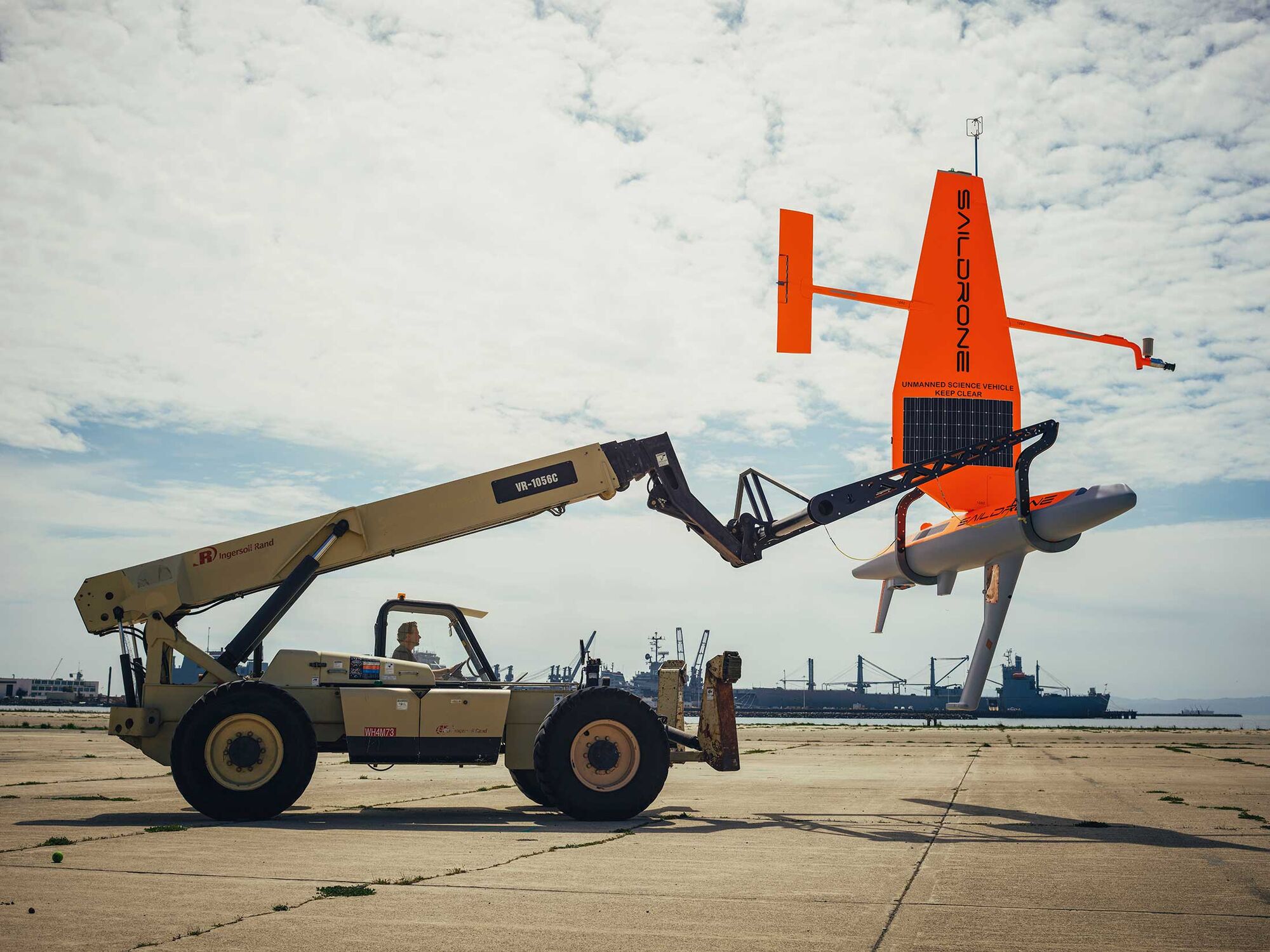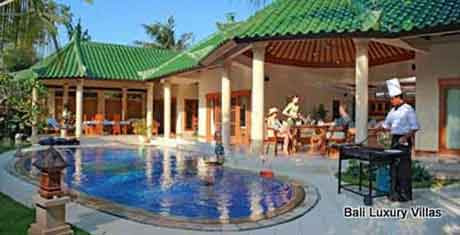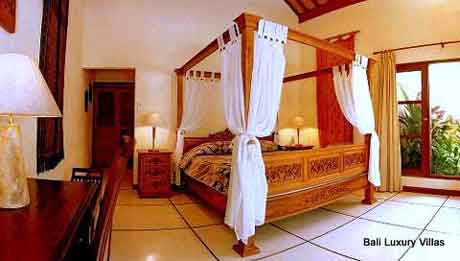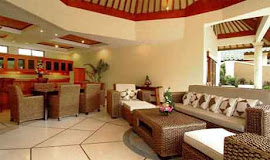By
Ashlee VanceMay 15, 2018, 5:14 PM GMT+8
From
Every spring, thousands of great white sharks begin a mysterious migration. From up and down America’s West Coast, they head straight for a Colorado-size patch of the Pacific about halfway between San Diego and Hawaii. Once there, they hang for months at what marine biologists call the White Shark Cafe, frolicking and diving 1,500 feet or more. For decades, we didn’t know much more about what they do there—or why. This year, we should get some answers, thanks to a pair of saildrones.
Each drone is a 23-foot neon-orange sailboat that catches wind with a solid wing more durable than a cloth sail. As the name implies, they’re seaworthy, autonomous robots, though a human pilot can take control remotely. In mid-March, two saildrones packed with sensors, cameras, and scientific instruments launched from a dock in the Bay Area city of Alameda, gliding past Alcatraz and beneath the Golden Gate Bridge to begin a three-week, 1,200-mile journey to the Shark Cafe.
By early April, the saildrones arrived and began picking up signals from a group of 37 sharks that researchers had tagged with acoustic transmitters. The drones pinpointed the sharks’ locations, then sailed back and forth, using sonar to see what they were up to. Via satellite, the drones relayed images and other data to Barbara Block, a Stanford marine biologist who started planning a research voyage to the Cafe three years ago. Block has studied these sharks for much of her career, but this was her first detailed look at their vast deepwater playground.

A saildrone off the coast of San Francisco on April 5, 2018.
PHOTOGRAPHER: BALAZS GARDI FOR BLOOMBERG BUSINESSWEEK
“We’re talking about a place that is a long way from anywhere, that few people have ever been to,” Block says. “Then I’m sitting in my office, and the images start to appear of the sharks doing dives in these day and night patterns. What I saw was almost unbelievable.” The sharks appeared to be diving toward a layer of deep ocean teeming with fish, which suggested they came to the Cafe to dine. Block has since set out with a dozen researchers to sail alongside the robotic scouts and learn whether some special kind of food, or perhaps a romantic getaway, helps draw the sharks to the middle of nowhere. “This is one of the largest migrations, one of the largest stories, and we don’t know enough about it or about what goes on in the ocean overall,” she says. “I think this type of technology will help us fill in the gaps at a crucial time for our planet.”
The robotic vessels come from an Alameda startup called Saildrone Inc. Backed by $90 million in venture capital, Saildrone is a big bet on the market for information about the ocean. Founded in 2012, the company has spent the past few years proving its 1,200-pound craft can withstand months of punishing waves to churn out precise data far more cheaply than a traditional research vessel. Within four years, it wants a fleet of 1,000 drones scanning the world’s oceans more or less constantly. The objective: salable insight into the environment, weather, fishing, shipping, and oil and gas exploration.
This plan rests on Richard Jenkins, an engineer, sailor, and adventurer who invented the saildrone more or less by accident. Jenkins doesn’t act like one of Silicon Valley’s world-conquering capitalist nerds. For starters, he tends to skip the usual platitudes about disruption to focus on sailing, beer, and sailing with beer. “What’s the definition of a sailor?” he asks while launching one of the drones off the Alameda dock. “A primitive organism for turning beer into urine.”
Jenkins, 41, is tanned, and his mop of bushy brown hair is flecked with streaks of blond from the sun. He often commutes by boat from his bayside home to Saildrone’s nearby headquarters at the water’s edge, and ties up his craft with hands calloused from years of rigging and fixing sea-addled machinery. His office attire consists of a ratty T-shirt and khaki pants stained with grease, paint, and epoxy.
Jenkins’s accent is tough to place, and for good reason. He was born in England to Australian parents, and spent much of his childhood bouncing between his home near the yachting mecca of Southampton and his grandfather’s farm in Western Australia. At age 12, he began making his own sailing dinghies and other small vessels. His parents’ living room became a workshop, with hulls in place of the couch and spare parts covering the TV. “My parents were pretty tolerant,” he says.

Jenkins, with downtown San Francisco behind him.
PHOTOGRAPHER: BALAZS GARDI FOR BLOOMBERG BUSINESSWEEK
The tinkerer never took to school. He claims the only nontechnical book he’s ever read is Sun Tzu’s The Art of War. But by age 14, he was studying carpentry and, in night classes, traditional wooden boat building. At 17, he went to work for local builder Green Marine, helping to make racing boats, sailboats, and luxury yachts. Before enrolling at Imperial College London to study mechanical engineering, he took a year off to sail the world, delivering the yachts he’d built.
While an undergrad, Jenkins’s mates at Green Marine approached him about trying to make the fastest-ever version of a land-sailing yacht. The confusingly named craft looks a lot like a sailboat, except that it travels on wheels and usually traverses desert tracks. At the time, the world speed record for a land-sailing yacht stood at 116.7 mph. From 1999 until 2009, Jenkins devoted his life to beating it.
That meant spending months at a time in American and Australian deserts, pushing his designs across dry lake beds. During winter, Jenkins traveled to Montana or Canada and ran his yachts on the ice. He paid out of his own pocket and kept budgets tight. “I spent $110,000 over the 10 years, including my living costs, building the vehicles, and transportation,” he says. “I recorded all the receipts because I kept thinking a big sponsor would come through and pay it all back.”
Mostly, Jenkins lived on his own, sleeping in an $800 Dodge van. “I would work on the vehicle during the day and eat steak and corn, the diet of kings, at night,” he says. One day, an ex-highway patrolman spotted Jenkins in the desert, and gave him a handgun and a huge bag of bullets. “He said, ‘There are freaks out there,’ but I never saw anyone,” Jenkins says. “So I just drank a lot of beer and shot at the cans.”
In his solitude, Jenkins kept learning about engineering and aerodynamics. He tried adjusting the size of the wing, the racing tires, and the land yacht’s materials and shape to find the right balance of force and drag. Most days brought setbacks. Once, a 25-pound hunk of metal flew off the vehicle and into the cockpit, just missing his head.
Over the course of his decade in the wild, Jenkins went to extremes to keep his project going. For a while, he earned extra cash working in a nickel mine, climbing 1,500 feet down a rickety ladder with fertilizer on his back to blow up rock around promising seams. Occasional floods at his campsite sometimes stranded him for weeks at a time.

Workers manufacture Saildrone components at the company’s factory in Alameda, Calif., on April 4.
PHOTOGRAPHER: BALAZS GARDI FOR BLOOMBERG BUSINESSWEEK
The land-yacht breakthrough came around 2008. On a model with a long, narrow body, Jenkins attached what looked like an airplane wing, only vertical, behind the cockpit, with a rod with a rectangular tail about a third of the way up. Wind passing around the wing created forward lift, propelling the vehicle at three to five times wind speed. With pulleys and hydraulics, Jenkins could adjust a small tab on the tail to tweak the angle of the sailboat’s wing even at high speed without spinning the vehicle out of control. In March 2009, he invited observers to Ivanpah Dry Lake in the Mojave Desert to watch his land yacht, the Greenbird, hit 126.1 mph and crush the previous record.
“Once you say you’re going to do something, you have to do it, right?” Jenkins says. There was no other immediately obvious reward. “Potential sponsors would always ask if there was anything about the vehicle that could be commercialized,” he says. “The problem was, I could never think of a single thing.”
Alameda is a small, sleepy island of 80,000 located next to Oakland and across the bay from San Francisco. Six miles long and a mile wide, it’s full of Victorian houses and has a citywide speed limit of 25 mph. At the island’s western edge sits an old Naval air station with giant warehouses where ships and fighter jets were once built. More recently, rocket makers and vodka distilleries have set up shop there. In 2009, so did Jenkins, eager to figure out what came after the land yacht.
For two years, Jenkins and a couple of boat building pals rented a little slice of a warehouse for what amounted to a very niche consulting business. They built specialized kitesurfing boards for the likes of Google co-founder Larry Page. “Richard was a bit lost,” says Damon Smith, one of the pals. “It was probably the first proper job he’d ever had.”
Quickly, the record-breaker in Jenkins got the best of him again. How cool would it be, he thought, to replicate Magellan’s 16th century globe-spanning voyage with a modern twist and less death? Using a tail like the one he put on the land yacht, he figured, it might be possible to build a drone sailboat that could take itself around the world, powered by the sun and guided remotely as needed.
“They’ve all come back without a single scratch, just a beard of barnacles”
By 2011, Jenkins had a prototype, and he started to think it could be useful for scientific research, as well. That year, he crossed paths with Wendy Schmidt, the businesswoman, philanthropist, wife of former Google chief executive Eric Schmidt, and co-founder of the Schmidt Ocean Institute, which has invested in oceanographic research vessels. “The idea of having a vessel that could be self-propelled and go where large, expensive research ships can’t was appealing,” Schmidt says. “He needed some money, and we were able to give it to him for research and development.”
Scientists and the more business-minded felt Jenkins had little hope of protecting his robotic boats and their data from the storms and salt that threaten even the largest of ships. Undeterred, he began testing in 2013. By the end of the year, one drone had traveled 2,100 nautical miles from San Francisco to Hawaii in 34 days, the first unmanned vehicle to cross an ocean by wind power. Since then, saildrones have survived 40-foot waves in the Bering Sea and pushed through the low-wind doldrums near the equator. “Our longest mission has been eight months and 10,000 miles, and we’ve gone 200,000 miles overall,” Jenkins says. “They’ve all come back without a single scratch, just a beard of barnacles.”

Assembling a saildrone.
PHOTOGRAPHER: BALAZS GARDI FOR BLOOMBERG BUSINESSWEEK
On launch day for the Shark Cafe trackers, Jenkins, driving a forklift with long, extendable arms, lowers two drones into the bay. With help from a few of his roughly 60 employees, this takes about 10 minutes per drone. The boats don’t get names. “They are robots,” Jenkins says sternly, “and they should not have personalities or anything that leads to an emotional attachment.” He did, however, spend the morning painting smiling shark faces on them.
As it plans to explore the seas, Saildrone has taken over the whole of its 200,000-square-foot warehouse at the old Navy port. At a series of workstations, each task is done by hand: body sculpting, epoxy spreading, painting, electronics testing, and baking parts in ovens to make them more durable. Every bit is designed by Jenkins and his team.
Saildrones are 23 feet long, 15 feet high, and a foot or so across. The words “unmanned science vehicle” are stenciled in black letters across the eye-scorching orange mainsail. Most of the body is a lightweight, sturdy carbon-fiber composite, and the rest is plastic and ceramic—all resistant to saltwater. The sail and body include homemade solar panels that match the craft’s curves, powering the suite of electronics scattered from the hull to the keel. Fully loaded, a saildrone can travel at a speed of 3 knots to 8 knots (3.5 mph to 9.2 mph).

An iPhone runs the Saildrone app that remotely controls a drone during a test run in San Francisco Bay on April 5.
PHOTOGRAPHER: BALAZS GARDI FOR BLOOMBERG BUSINESSWEEK
From his iPhone, Jenkins can monitor any saildrone around the world. Guiding one is as easy as placing a dot at a starting point and another dot at a destination. AI software takes care of the rest, keeping the craft within a corridor Jenkins can set as wide as 50 miles or as narrow as 15 feet. He tries to avoid major shipping lanes, oil rigs, and buoys. If a drone senses it’s going slower than expected, it concludes it’s caught in netting and starts to reverse to get free. Jenkins says none has ever crashed or been abducted by pirates, but onboard cameras have shown the occasional seal hopping aboard for a rest or to get away from a predator.
Each drone carries at least $100,000 of electronics, batteries, and related gear. Devices near the tip of the sail measure wind speed and direction, sunlight, air temperature and pressure, and humidity. Across the top of the drone’s body, other electronics track wave height and period, carbon dioxide levels, and the strength of the Earth’s magnetic field. Underwater, sensors monitor currents, dissolved oxygen levels, and water temperature, acidity, and salinity. Sonars and other acoustic instruments try to identify animal life.
A slow, expensive satellite internet connection feeds crucial bits of data back to the company and its clients in real time. The rest can be retrieved from hard drives once the bots return to shore. The biggest questions for Saildrone are who will pay for all the data it’s possible to collect—and what they’ll do with it.
Despite the ocean’s size and value, resources to study it are scant. The U.S. National Oceanic and Atmospheric Administration, or NOAA, is among the field’s best-funded research organizations and has all of 16 science ships, complemented by another 16 from university fleets. Australia has only one serious research vessel. Much of the data about global seas come from satellite readings and a smattering of sensor-equipped buoys. “It’s just not much,” says Christian Meinig, an NOAA engineer for three decades. “We’re spending more to learn about water on Mars than on Earth.”
The NOAA ships and their like can cost $80 million to $150 million to build. It’s another $50,000 to $100,000 a day to run them, and the longer the mission, the pricier logistics get. “It’s fuel, consumables, and I don’t even want to tell you what our satellite bill is for data,” says Andreas Marouchos, a research group leader with the Commonwealth Scientific and Industrial Research Organisation (CSIRO), Australia’s science agency. For the lucky few who score grants, there’s a brewing cultural problem: Younger researchers no longer want to spend that much time at sea, cut off from most of the internet. “It’s really hard to get the younger generation excited about going to sea,” says NOAA’s Meinig. “People think it’s romantic and then find they can’t text their friends and don’t have access to hundreds of channels of TV. It’s just a different style of life.”
Saildrone says its craft are meant to work in tandem with human researchers to ease these burdens. Scientists and businesses can rent one for $2,500 a day. The drone heads to its selected destination and gathers data, which Saildrone helps process and analyze. The company has built about three dozen drones so far and says it plans to complete 200 by the end of the year. Building 1,000, the number Jenkins figures would be enough for round-the-clock assessments of the oceans, could cost upwards of $100 million, though that’s still cheaper than a single NOAA research ship.
The saildrones’ array of equipment lets them modernize key marine biology tasks. In the Bering Sea, between Alaska and Russia, NOAA has one ship monitoring fish stocks to set quotas for a $1.3 billion commercial fishery. “We’ve been doing this process the same way for 100 years,” says Meinig. “We drag nets and count the fish.” With a saildrone, NOAA can use sonar to calculate the biomass of the fish and, soon, DNA sampling systems to determine which species are around.

The Alameda factory.
PHOTOGRAPHER: BALAZS GARDI FOR BLOOMBERG BUSINESSWEEK
NOAA says it plans to use about two dozen saildrones in the next year for missions that include weather and climate change research. CSIRO just put three in the water off the coast of Tasmania as part of a series of yearlong missions. They’ll be sailing up the eastern coast of Australia to the climate-change-devastated Great Barrier Reef, monitoring animal life and water health and looking for places to bury atmospheric carbon under the ocean floor.
Saildrones may be most useful for weather forecasting. The robots can pick up and map much richer data than the sparse, static sensors used to build forecasting models today. “If the data gets that much more accurate, there will be weather prediction like we can’t even imagine today,” says Dipender Saluja, a partner at Capricorn Investment Group, a Saildrone investor. “It will affect transportation, logistics, agriculture, and energy markets.”
Take Superstorm Sandy. As it approached New York in 2012, European and U.S. models differed about the temperature of the water in front of the storm, a significant factor in determining its strength. The U.S. model reported that the water was cool, which would weaken Sandy’s intensity, while the European model saw warmer water that would exacerbate the storm’s devastation. (That one was right.) Soon, Saildrone plans to send its robots right into hurricanes to relay information about water temperature and other conditions. Along with the strength of the storms, such data can also provide better measures of when and where they’ll make landfall.
The humanitarian and scientific missions seem obvious enough, but will they yield enough data business to justify the hardware and management costs? Far more competition for big contracts is coming, including sailboats, surfboards, and other vehicles from startups with names such as AutoNaut, Ocius Technology, Sailbuoy, and Ocean Aero. NOAA’s Meinig worries that military and energy-industry money will prove too tempting for many otherwise-altruistic researchers. “Our challenge as scientists, frankly, is conveying the need here to get people and Congress to increase their funding,” he says.
Liquid Robotics Inc. offers a cautionary example. It started in Silicon Valley in 2007, making a robotic surfboard that harnessed wave motion to propel itself. Like Saildrone, Liquid Robotics began working with NOAA and other science agencies on weather and marine-life research missions. Eventually, however, it turned away from that work. “There is no money in the science market,” says Chief Executive Officer Gary Gysin. “The research organizations and NGOs are never going to throw $100 million at a problem and go solve it.”

Outside the Saildrone facility in Alameda.
PHOTOGRAPHER: BALAZS GARDI FOR BLOOMBERG BUSINESSWEEK
In 2016, Boeing Co. acquired Liquid for $300 million, and the company has since moved into military and commercial work. Its robotic gliders lurk out at sea, watching the movements of boats and submarines and trying to spot illegal fishing. At oil and gas rigs, they provide weather data to help manage platforms’ operations and environmental data to make sure the drillers are complying with regulations. Liquid charges $5,000 a day per glider and has about 400 of them at sea. “Unless you transition to a commercial program,” Gysin says, “you will never get to build a real business.”
Saildrone’s investors say they’re taking a longer view, and that a global database of the oceans will benefit the company’s future more than chasing whatever business it can book today. “The most important asset is the data, and getting data that no one else can accumulate,” says Chamath Palihapitiya, founder of investor Social Capital. Palihapitiya, like several of Saildrone’s other big backers, tends to support companies with social and environmental bents, and to allow for a bit more time to work out a business.
Still, Jenkins has been paired with Chief Operating Officer Sebastien de Halleux, who has a long track record of turning startups into big businesses. It’s de Halleux who convinced Jenkins that money could be made from understanding the weather. “Sebastien will keep it tethered, while Richard does his thing as a creative genius,” says Palihapitiya. Saildrone plans to sell data to all comers, building a software platform that almost anyone can tap, and to go after commercial work, particularly with fisheries and logistics companies.
Like Jenkins, de Halleux is a sailor, and he’s been coaxed into land yachting by his business partner. On the weekends, their families head out to the desert and try out prototypes while the two executives compete to see who can put back more beer. “I’m Belgian and he has Australian roots, so there’s a love of cheap lager and lots of it,” de Halleux says. “I still think I can drink him under the table.”
Later this year, possibly by August, they plan to revive the goal of replicating Magellan’s voyage with a couple of saildrones. In order to make the circumnavigation official with the World Sailing Speed Record Council, the drones must start out in the Northern Hemisphere, cross every longitude line, and cross the equator twice. “We’ll fulfill all of our contracts first, and as soon as there is a boat available, we’ll set them off,” Jenkins says. “It’s all about priorities, right?”












No comments:
Post a Comment